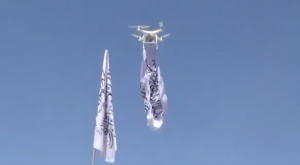SAYED KARAM, PAKTIA, AFGHANISTAN — While the Taliban have since at least 2016 used camera-equipped commercial drones to film propaganda footage, it was, as far as it could be determined, only in early October 2020 that they began to use such unmanned aerial vehicles for attacks. Although, as of writing, there have been few such attacks with weaponized commercial drones, they are significant for several reasons. They exemplify that the Taliban remain — despite engaging the Afghan government and other Afghan stakeholders in peace negotiations — intent on fighting the Afghan government and employ new, ingenuous tactics to do so. Furthermore, and even though the impact of such drone attacks has so far remained limited, they threaten to demoralize Afghan government forces who perceive themselves to face a better-equipped enemy.
Taliban Bomblets from the Sky
The first snow of the year barely covers the barren ground of the plain that stretches to hills and mountains on the horizon in Paktia’s Sayed Karam district. To the left and right of a simple country road, qalas dot the scenery — traditional Afghan compounds surrounded by high ochre mud walls whose corners often consist of small sturdy towers. On one of the qalas an Afghan national flag flies in the cold winter air. Other Afghan flags top a few outposts of Afghan government forces that protect the road which connects Paktia’s capital Gardez, a small town a mere two hour’s drive south of Kabul, with the province’s eastern districts.
The outposts are barely more than enclosures of HESCO-barriers. The 10 to 20 Afghan police officers manning each of them have a difficult life fending off regular Taliban attacks. While the bullet holes in the HESCOs bear silent witness to the common ground attacks, recently, the policemen have faced a new threat.
“It was about one and a half months ago, when the Taliban attacked our outpost with a drone for the first time,” Emal, the commander of the outpost in Alamgai Market in Sayed Karam, told The Diplomat on November 21, 2020. “Within less than three weeks after the first incident, Taliban drones attacked again three times. They always came in the dark, between 2100 and 2300, and dropped single mortar rounds,” he added. “The first time, three of my men were slightly wounded; afterwards, the drones only caused damages to vehicles and a HESCO.”
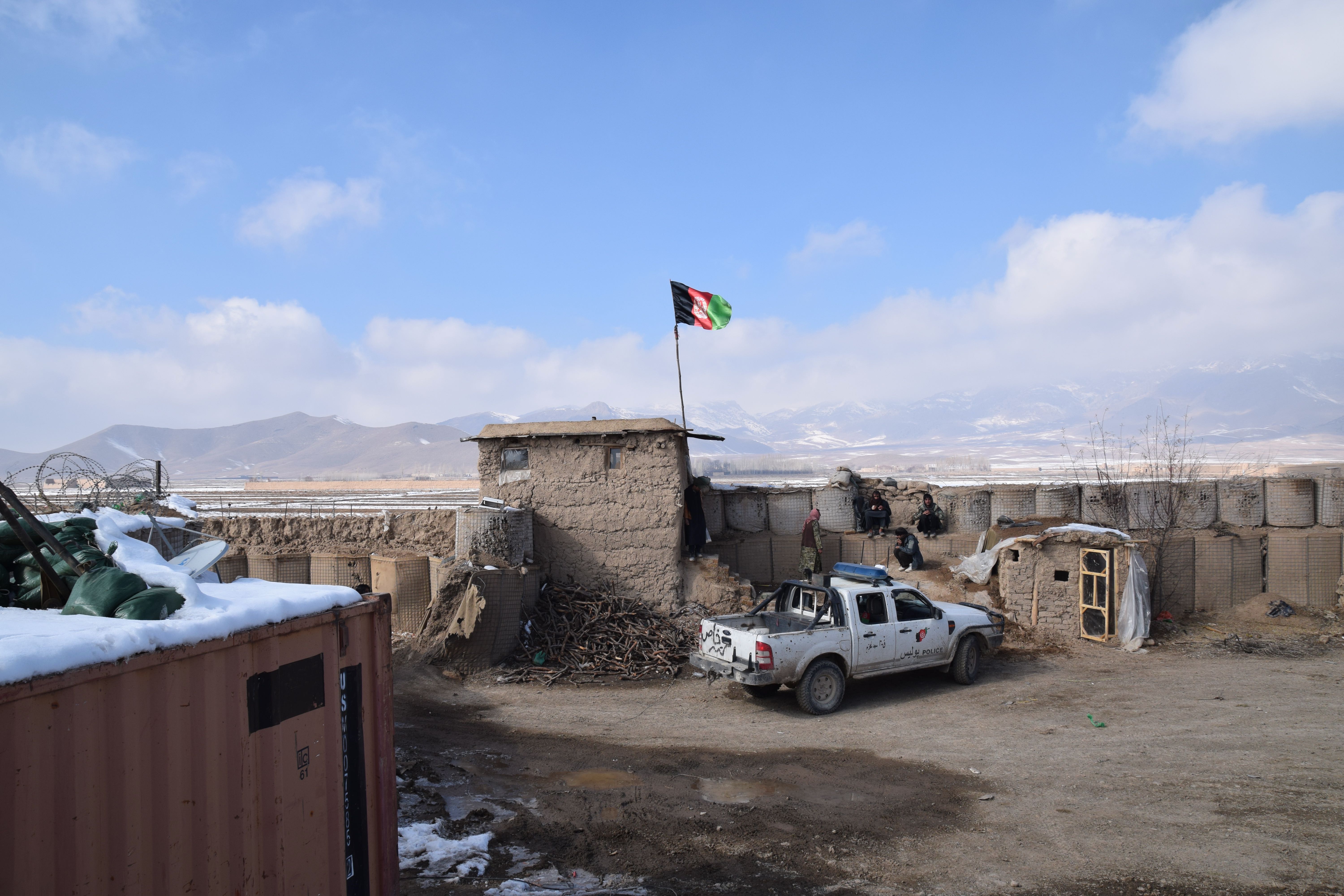
Alamgai Market outpost, one of three outposts in Sayed Karam, Paktia, Afghanistan, that was attacked by Taliban drones in October 2020 (Franz J. Marty, November 21, 2020)
Another policeman from the district center of Sayed Karam claimed that in some instances, Taliban drones had dropped improvised bomblets made out of plastic Pepsi bottles filled with explosives and closed with a trigger in the bottle neck. And a video that was later shared on Twitter and allegedly taken in Khost, a province neighboring Paktia, showed a 40 mm M433 high-explosive dual purpose grenade cartridge that is usually meant to be shot with a grenade launcher but was apparently modified to be triggered on impact when dropped from a drone. A similar cartridge was also depicted in photos of the remnants of a weaponized Taliban drone that Afghan government forces reportedly shot down on or around December 19, 2020, in Charkh District in Logar Province just north of Paktia; in this case, the pictured cartridge was modified with a shuttlecock to stabilize its drop. The latter type of ammunition seems particularly plausible, if one considers the limited payload that the commercially available drones that the Taliban likely use are able to carry.
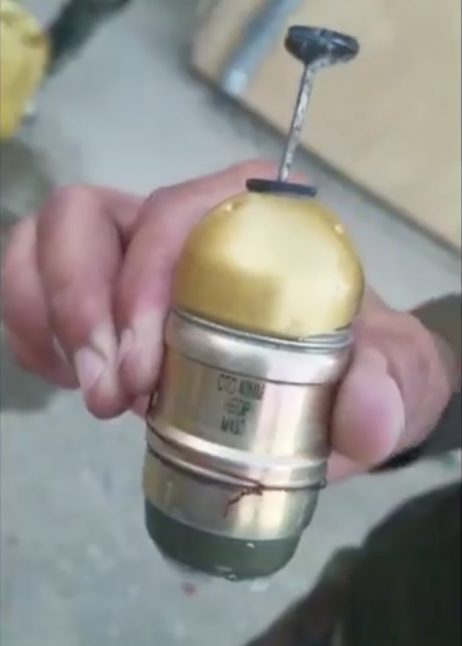
A 40 mm M433 high-explosive dual purpose grenade cartridge that was apparently modified to be triggered on impact when dropped from a drone; reportedly found in Khost, date unknown. Source: Twitter.
Whatever ammunition the Taliban use, Emal asserted that “each time after the mortars from the drones hit, Taliban fighters attacked on the ground from all four sides, but we repelled them.” Commander Koka, a short wiry former army soldier with shoulder-long hair who commands a local anti-Taliban militia out of the qala with the Afghan flag, described similar Taliban attacks. Except that he says that the Taliban first fired from the ground and only dropped munitions with a drone after the shooting drew his men out of their simple accommodations. “The Taliban attacked us with a drone on three occasions,” he asserted, “once the explosion wounded two of my men.”
In addition to the seven mentioned attacks, Taliban drones also dropped bomblets on one other police outpost in Sayed Karam. Reports indicated additional attacks with Taliban drones in Paktia’s districts of Mirzaka and Zurmat, Baraki Barak, Charkh, and Pul-i Alam in the neighboring province of Logar, and the northern Afghan city Kunduz.
What Type of Drones Are the Taliban Using?
What type of drones the Taliban are using is difficult to determine. “When the attacks happened, it was dark, so I could not see the aircraft,” Sawab, a mustachioed policeman in the Alamgai Market outpost, recounted, “but you could hear that is was a drone; it sounded like a generator or a circular saw.” Men in the other two outposts in Sayed Karam visited on November 21, 2020 stated the same, independently from each other describing the generator-like sound of rotors.
Rahimullah, another policemen in the outpost in Alamgai Market, asserted that the drone had four propellers. He was, however, apparently just describing the photo of a weaponized commercially available quadcopter which Emal later showed on his smartphone — a photo, as it turned out, depicting a weaponized drone in Iraq. Similarly, a man in Commander Koka’s qala as well as a high-ranking government official in Gardez claimed to have photos of the drones that the Taliban used, but were then flashing pictures of an armed, not freely available, Chinese drone that were clearly not from Afghanistan and probably taken from pro-Taliban accounts on social media that had also shared them. Accordingly, and as experience shows that people frequently take random online pictures as proof without checking whether images are actually showing equipment used in Afghanistan, these photos are not indicative of what types of drone the Taliban actually use.
There is, however, some proof that the Taliban use over-the-counter quadcopters to which they fix a dropping mechanism for bomblets. This derives from the already mentioned pictures of the remnants of a weaponized Taliban drone that was apparently shot down in Afghanistan very recently as well as the fact that footage from Taliban propaganda shows that the Taliban possess quadcopters (see for example here). In one short video that was shared on Twitter in January 2020, two Taliban speaking in Pashto, one of Afghanistan’s national languages, even present a weaponized commercially available DJI Matrice 210. They claim, however, that the weaponized drone in question had been seized by the Taliban in Garmsir District in the southern Afghan province of Helmand, after it had allegedly been used against the Taliban by a party that they do not name in the brief video — which is strange as there are no indications that any anti-Taliban forces in Afghanistan would use commercially available drones, not to speak of weaponized ones.
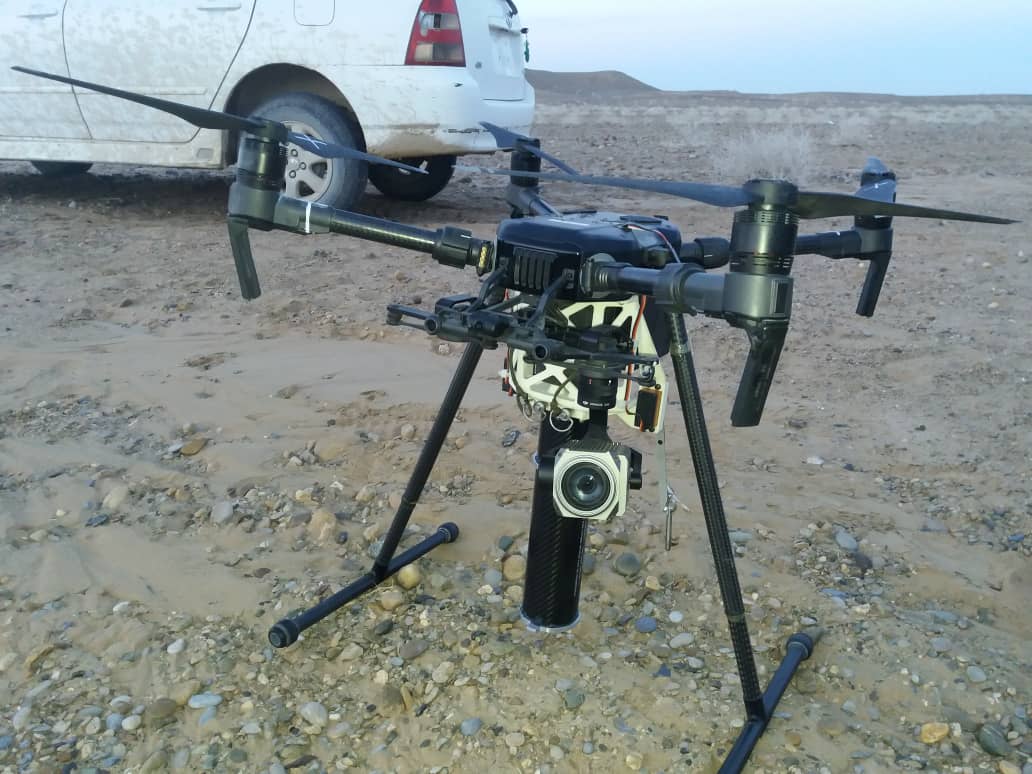
Photo of a weaponized DJI Matrice 210, reportedly taken by Taliban in Garmsir District in the southern Afghan province of Helmand; date unknown, shared on Twitter on January 20, 2020. Source: Twitter.
That the Taliban likely use commercially available quadcopters was further corroborated by two well-placed government sources in Paktia. One of them stated that he had seen a photograph taken by a source with access to insurgents in Paktia which showed a weaponized quadcopter like the one in the above mentioned video; just in white instead of black. And the other source asserted that Afghan government forces had, before the attacks in Sayed Karam, seized a quadcopter from insurgents in Paktia’s Zurmat district.
Source of the Taliban Drones?
“Four Pakistanis have brought the drone that was used to attack us about two months ago,” Emal asserted in late November 2020, when asked about the origin of the Taliban drones. “We know this from reports of local sources.” Also Commander Koka was adamant that the drones come from Pakistan, saying that “we can hear [the men that brought and use them] talking in [the Pakistani languages] Urdu and Punjabi over the open radio channels they use; that’s how we know.”
While it is possible that the Taliban got their drones from Pakistan, the above assertions should be taken with a huge grain of salt. This derives, amongst others, from the aforementioned fact that the same sources had also asserted to have photos of the Taliban drones, which, it turned out, were not from Afghanistan. In addition, experience in general shows that Afghans are quick to claim that the Taliban get any equipment from Pakistan or other states, although this is often questionable (for an example, see this analysis on night/thermal vision scopes used by the Taliban).
Accordingly, it is more likely that Afghan government forces as well as officials do not know where exactly the Taliban obtained the drones — which was openly acknowledged by an Afghan policeman in Gulshoh Qala, the second attacked police outpost in Sayed Karam. Ahmad Zia Saraj, the head of the National Directorate of Security (NDS), Afghanistan’s intelligence service, on November 23, 2020, also implied that the commercial drones that the Taliban used were regularly imported by vowing that the NDS plans to prohibit the import of commercial drones into Afghanistan to curb such attacks. With such drones being freely available in many countries and prices ranging from $700 for a used DJI Phantom 2 to several thousand dollars for more elaborate drones (drones of the DJI Matrice 200 series start, for example, at around $6,500), such drones are, even though not cheap, also not prohibitively expensive. In view of all the above and in absence of serial numbers, it is therefore extremely difficult to determine where the commercial drones that the Taliban use have come from.
The same holds true for the question of how exactly they were weaponized. “Weaponizing such drones is surprisingly easy,” Nick Waters, an analyst with Bellingcat, who has researched the use of weaponized commercial drones in detail, stated. “While I am not aware of exact step-by-step guides how to weaponize commercial drones, it does not take much knowledge and work and a detailed guide is not necessary,” Waters added.
Why the Taliban only recently started to use weaponized commercial drones, despite having access to such drones for years, could not be determined. A likely, albeit speculative explanation is that the Taliban, whose members are mostly uneducated, might have trouble accessing and acquiring even comparatively simple knowledge and methods to weaponize commercial drones.
Impact on the Battlefield
So far, the impact of weaponized Taliban drones on the Afghan battlefield has been negligible, as there have been only few such attacks that have, in almost all cases, caused little, if any relevant damage.
This could, however, change.
“The main problem with the use of weaponized commercial drones is to deploy effective ammunitions as the payload of such drones is usually very limited; this can be resolved though by using larger drones that can lift heavier munitions or by producing custom-made ammunitions, as insurgents had done in Syria,” Waters explained. “Furthermore, if insurgents master how to accurately use weaponized drones they can — even with small-yield ammunitions — cause significant casualties and damages. This was shown in Syria, where, alone in 2017, at least 208 strikes with commercial drones were documented and these strikes had become accurate and feared.”
What might be even more relevant than the direct impact of ammunitions dropped by drones is the psychological effect they can have on opponents.
“Videos from Syria show that, over time, the mere sound of a commercial drone caused fighters to flee and abandon their position out of fear to be targeted by dropped ammunitions — so the sound of the drone itself could be used as a weapon,” Waters stated in this regard.
Given that the Afghan policemen in Sayed Karam lamented that the Taliban’s use of drones and night vision scopes would show that their enemy is better equipped than they themselves, there are already signs of a demoralizing effect. This, in turn, carries the risks that Afghan government forces might, if faced with further Taliban drone attacks, more likely abandon their positions and cede territory to the Taliban — all the more as there have already in the past been reports that Afghan government forces vacated outposts without much of a fight (see for example here and here).
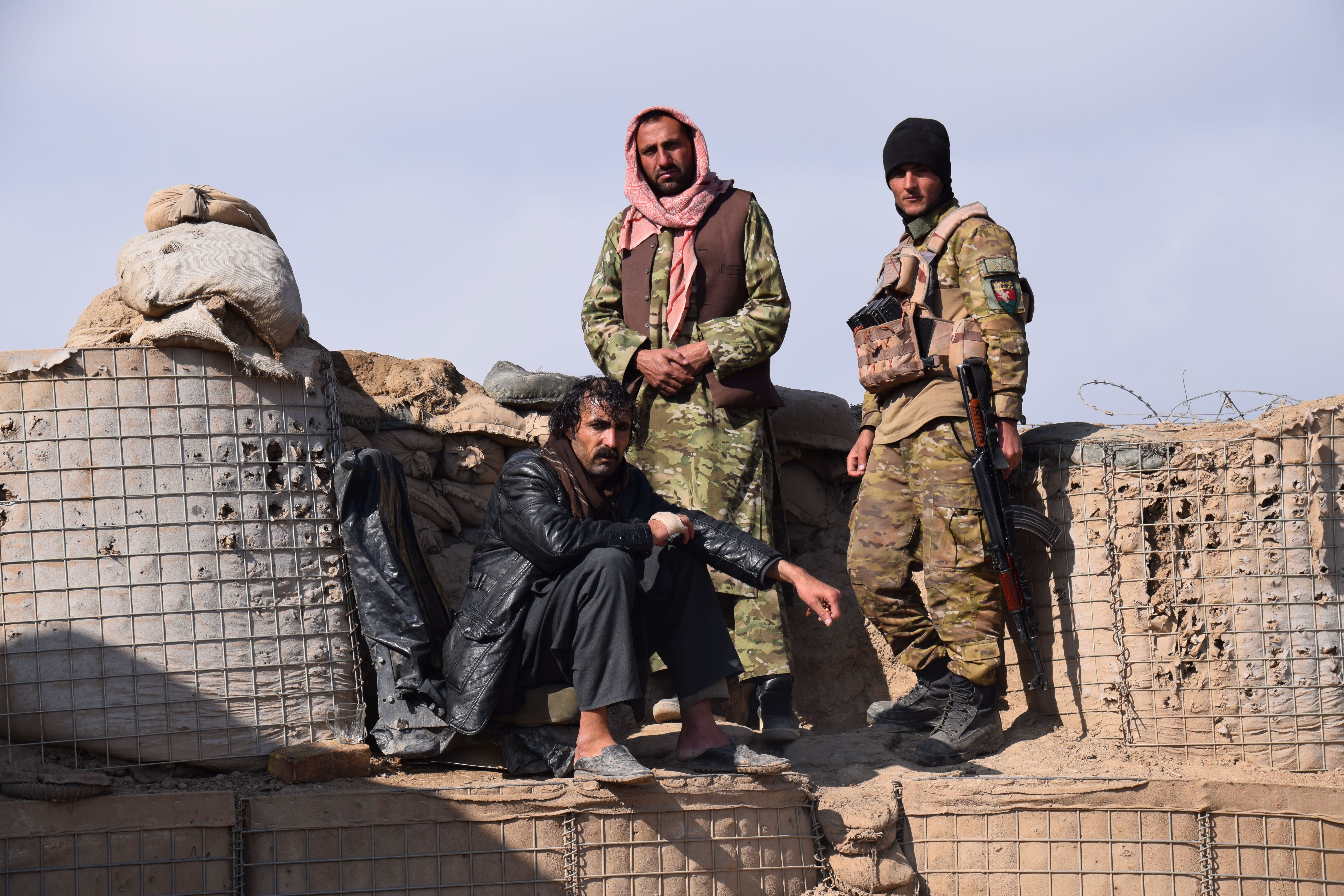
Afghan policemen in Alamgai Market lament that their Taliban foes are better equipped than they themselves (Franz J. Marty, November 21, 2020)
Whether and to what extent the Taliban will continue, expand and/or improve their use of weaponized commercial drones is hard to predict. The Afghan policemen in Sayed Karam stated that the several drone attacks that the Taliban had conducted during October 2020 had, as of December 18, 2020 not been followed up. In this regard, a well-placed local government source in Paktia claimed that reports suggested that the Taliban had moved the drone to another, unknown location. While there have been subsequent claims of Taliban drone attacks from other provinces (see here, here, here, and here), the alleged moving of the drone from Paktia could neither be verified nor disproved
Be that as it may, as the documented Taliban attacks with commercial drones have, despite having had limited impact, not been unsuccessful, it has to be feared that the Taliban will continue to use weaponized drones. This is all the more the case as reports about the Taliban’s use of drones for surveillance purposes have increased lately (see for examples here, here, here, and here), meaning that there does not seem to be a shortcoming of drones that could be weaponized. However, the fact that the Taliban have had access to commercial drones since at least 2016, but only recently started to use weaponized drones, suggests that their ability to expand operations with weaponized drones is limited and any such effort would take considerable time.
How to Counter Taliban Drones
Countering commercial drones is difficult. Although there are, according to a report on counter-drone systems by The Center for the Study of the Drone at Bard College in New York, a few hundred different systems to detect and interdict drones on the market, ranging from jammers to systems employing lasers or high power microwaves, the same report notes that “the technical challenge of countering drones has not yet been fully surmounted.” The report further states that “[c]ounter-drone technology is expensive,” putting the costs for most systems at more than $100,000. It further adds that countering drones in larger areas would cost multiple millions of dollars, referencing concrete examples from civilian airports.
Accordingly, and in view of a decrease in U.S. funding for Afghan security forces that the Afghan government can unlikely replace with other sources, it is doubtful that the Afghan security forces can afford counter-drone systems. Even if they could afford or would be provided with such systems by U.S. or NATO allies, the fact that Afghan security forces are already struggling to maintain simpler equipment would make this problematic and arguably ill-advised.
Shooting commercial drones down is also easier said than done. “In general, it is difficult to shoot down commercial drones, as they are small and hard to spot,” Waters explained. This is all the more the case as the Taliban appear to have, at least in Sayed Karam, deliberately launched their drone attacks under the cover of darkness, making it almost impossible to spot drones.
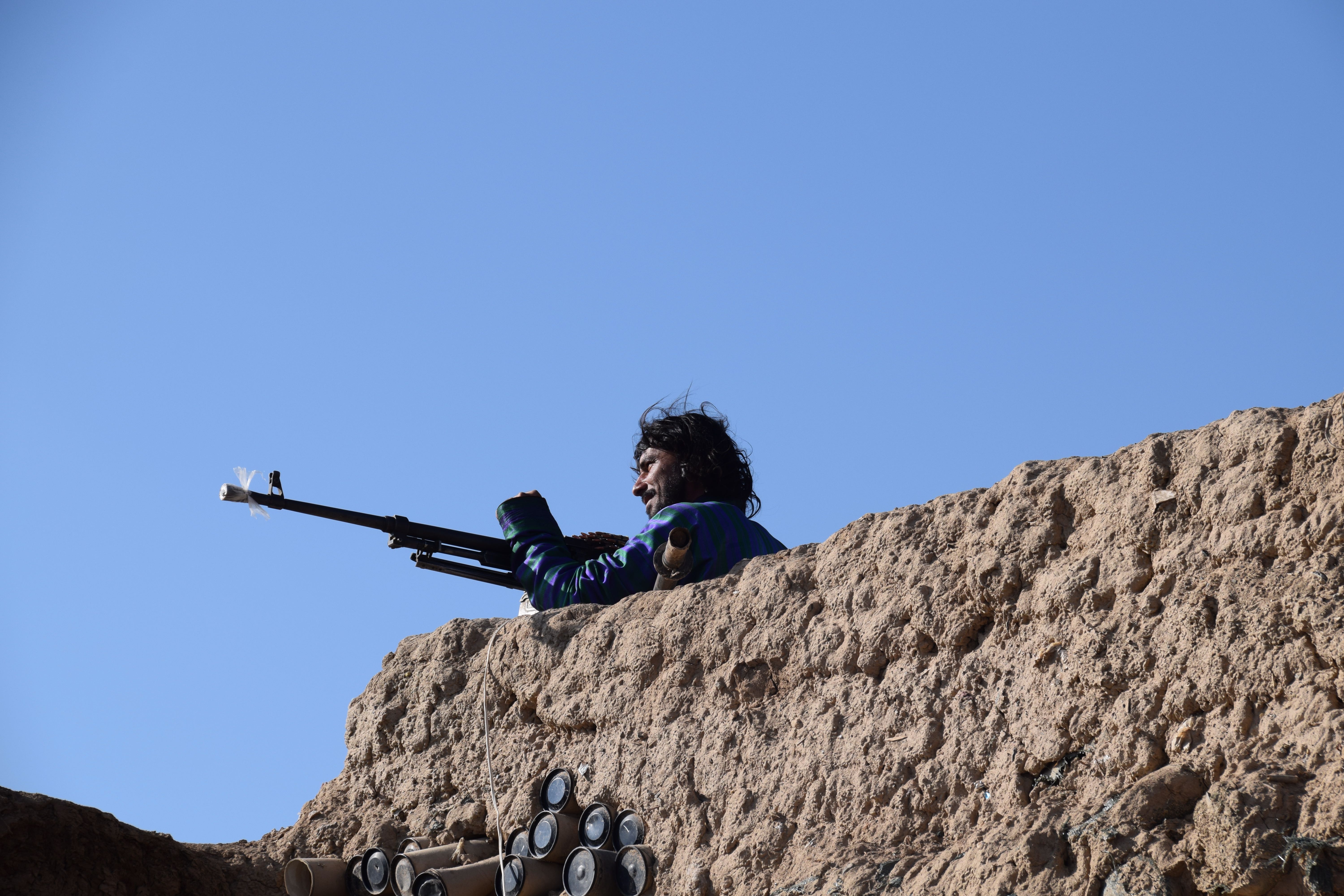
A member of the local anti-Taliban militia in Sayed Karam would have a difficult time to shoot a drone out of the sky, even if he would be able to spot it (Franz J. Marty, November 21, 2020)
Attempts to prevent the Taliban from acquiring more commercial drones, such as the above mentioned NDS plans to prohibit imports of commercial drones to Afghanistan, could at least in theory limit the spread of weaponized Taliban drones. However, as Afghanistan’s borders are porous, it would in practice be almost impossible to enforce such an import ban. This is, for example, shown by the fact that even though the Afghan government has, already in 2010, prohibited the import of ammonium nitrate, a chemical commonly used as fertilizer that is also a main precursor for home-made explosives, large amount of ammonium nitrate continue to get seized in Afghanistan.
In view of all this, the only realistic course of action might be that Afghan government forces have to adapt to the possibility of attack via weaponized commercial drones. This could, for example, be facilitated by covering all shooting positions and hardening roofs and walls enough to withstand detonations of comparatively small-yield munitions that Taliban drones are able to carry and drop. In many outposts such positions already exist to better shield soldiers from conventional attacks — as is the case in the qala of Commander Koka’s men, where they dug a basic bunker located half underground right below one of the corner towers of the qala from where they can fire at the Taliban through small embrasures.
In addition and in order to limit the demoralizing effect of Taliban drone attacks on Afghan government forces, Afghan policemen and soldiers should be clearly informed that such weaponized drones are far more easy to obtain and more limited in their attack capabilities than most of them seem to think.
Franz J. Marty is a freelance journalist based in Afghanistan. He writes on a broad range of topics, but focuses on security and military issues. You can follow him @franzjmarty on Twitter.













